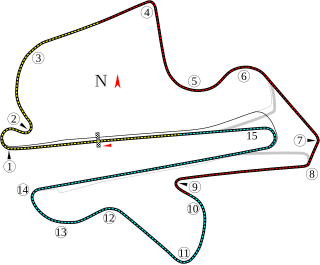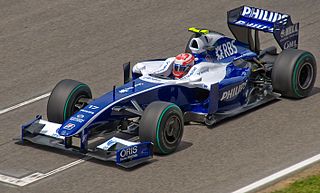
Williams Grand Prix Engineering Limited, currently racing in Formula One as Williams Racing, is a British Formula One team and constructor. It was founded by Sir Frank Williams (1942–2021) and Sir Patrick Head. The team was formed in 1977 after Frank Williams's earlier unsuccessful F1 operation: Frank Williams Racing Cars. The team is based in Grove, Oxfordshire, on a 60-acre (24 ha) site.

Alexander Georg "Alex" Wurz is an Austrian former professional racing driver, driver training expert and businessman. He competed in Formula One from 1997 until 2007, and is also a two-time winner of the Le Mans 24 Hours.

Nico Erik Rosberg is a German and Finnish entrepreneur and former professional racing driver. He competed in Formula One from 2006 to 2016, winning the World Drivers' Championship in 2016 with Mercedes-AMG Petronas Motorsport. The only child of Finnish 1982 Formula One World Champion Keke Rosberg and his German wife Sina Rosberg, he was raised primarily in the Principality of Monaco.

The 2007 FIA Formula One World Championship was the 61st season of FIA Formula One motor racing. It featured the 2007 FIA Formula One World Championship, which began on 18 March and ended on 21 October after seventeen events. The Drivers' Championship was won by Ferrari driver Kimi Räikkönen by one point at the final race of the season, making Räikkönen the third Finnish driver to take the title. An appeal by McLaren regarding the legality of some cars in the final race could have altered the championship standings, but on 16 November, the appeal was rejected by the International Court of Appeal, confirming the championship results. Räikkönen entered the final race in third position in the drivers' standings, but emerged as champion after the chequered flag, a feat first accomplished by Giuseppe Farina in 1950.

The 2008 FIA Formula One World Championship was the 62nd season of Formula One motor racing, recognised by the Fédération Internationale de l'Automobile (FIA) – the governing body of motorsport – as the highest class of competition for open-wheel racing cars. The championship was contested over eighteen races commencing in Australia on 16 March and ending in Brazil on 2 November. The 2008 season saw the debut of the Singapore Grand Prix, which was held at the Marina Bay Street Circuit, in Marina Bay, Singapore and was the first Formula One race held at night. The European Grand Prix moved to a new venue at the Valencia Street Circuit, in Valencia, Spain.

Kazuki Nakajima is a retired Japanese professional racing driver who drove in Formula One for the Williams-Toyota team from 2007 to 2009. In 2012 and 2014, he won the Super Formula Championship driving for TOM'S. Racing for Toyota Gazoo Racing, he won the 2018, 2019 and 2020 24 Hours of Le Mans, as well as the 2018–19 World Endurance Championship along with team-mates Fernando Alonso and Sébastien Buemi. He is the second FIA world champion from Japan after Toshi Arai.

The Williams FW28 was the car with which the Williams team competed in the 2006 Formula One season. The drivers were Mark Webber and rookie Nico Rosberg, the reigning GP2 Series champion. Webber was in his second year with the team, and teammate Nico Rosberg carried a hint of nostalgia, as Nico's father Keke had won the 1982 F1 championship in a Cosworth-engined Williams.

The 2007 Malaysian Grand Prix was a Formula One motor race, held on 8 April 2007 at the Sepang International Circuit and the second race of the 2007 FIA Formula One World Championship. Reigning world champion Fernando Alonso won the race from second on the grid, with McLaren teammate Lewis Hamilton finishing second. This marked McLaren's first one-two finish since the 2005 Brazilian Grand Prix. Previous race winner Kimi Räikkönen finished third. Räikkönen's Ferrari teammate Felipe Massa started the race from pole position, but was passed by both McLarens in the first two corners of the first lap, eventually finishing in fifth place behind BMW's Nick Heidfeld.

The 2007 Spanish Grand Prix was a Formula One motor race, the fourth race of the 2007 FIA Formula One World Championship, won by Felipe Massa. It was held on 13 May 2007 at the Circuit de Catalunya in Spain.

The 2007 Japanese Grand Prix was a Formula One motor race held on 30 September 2007 at the Fuji Speedway, Oyama, Shizuoka. The 67-lap race was the fifteenth round of the 2007 FIA Formula One World Championship. It was held at the recently revised track in very heavy rain and misty conditions. For the previous 20 years, the Japanese Grand Prix had been held at Suzuka Circuit, but at this race it returned to Fuji for the first time since 1977. The race was won by McLaren driver Lewis Hamilton, who also took pole position and the fastest lap of the race. Heikki Kovalainen achieved his first podium, by finishing second for the Renault team, whilst Kimi Räikkönen finished in third for Ferrari. Adrian Sutil scored Spyker's first and only point by finishing 9th and being promoted to 8th after the race.

The 2007 Belgian Grand Prix was the fourteenth race of the 2007 FIA Formula One World Championship, returning to the Formula One calendar after a year's absence. It was held on 16 September at the Circuit de Spa-Francorchamps, near the village of Francorchamps, Wallonia, Belgium.

The 2007 Italian Grand Prix was a Formula One motor race held on 9 September 2007 at Autodromo Nazionale di Monza, Italy. It was the thirteenth race of the 2007 FIA Formula One World Championship.

The 2007 Chinese Grand Prix was the sixteenth race of the 2007 FIA Formula One World Championship. It was held on 7 October 2007 at Shanghai International Circuit, Shanghai, China. The race was won by Ferrari's Kimi Räikkönen with Fernando Alonso finishing second and Felipe Massa finishing third. Championship leader Lewis Hamilton suffered the first race retirement of his Formula One career after going off at a wet pit entrance on worn tyres left him stuck in the gravel. Räikkönen's win marked the 200th Grand Prix victory for Scuderia Ferrari.

The 2007 Brazilian Grand Prix was a Formula One motor race held at the Autódromo José Carlos Pace in São Paulo, Brazil on 21 October 2007. The 71-lap race was the seventeenth and final race of the 2007 FIA Formula One World Championship.
Formula One sponsorship liveries have been used since the 1968 season. Before the arrival of sponsorship liveries in 1968 the nationality of the team determined the colour of a car entered by the team, e.g. cars entered by Italian teams were rosso corsa red, cars entered by French teams were bleu de France blue, and cars entered by British teams were British racing green. Major sponsors such as BP, Shell, and Firestone had pulled out of the sport ahead of this season, prompting the Fédération Internationale de l'Automobile to allow unrestricted sponsorship.

The Williams FW30 is a Formula One racing car, designed by Williams for the 2008 Formula One season. The car is largely an evolution of its predecessor, the FW29. As with its predecessor, the FW30 is powered by engines manufactured by Toyota. The FW30 was unveiled to the public on 21 January 2008 at the Circuit de Valencia, Spain, and made its race debut at the Australian Grand Prix and was driven by Nico Rosberg and Kazuki Nakajima.

The 2008 Hungarian Grand Prix was a Formula One motor race held on 3 August 2008, at the Hungaroring in Mogyoród, near Budapest. It was the 11th race of the 2008 Formula One World Championship. Contested over 70 laps, the race was won by Heikki Kovalainen for the McLaren team, from a second position start. Timo Glock finished second in a Toyota car, with Kimi Räikkönen third in a Ferrari. It was Kovalainen's first Formula One victory, which made him the sport's 100th driver to win a World Championship race, and it was Glock's first podium finish. It also turned out to be the only F1 race Kovalainen ever won.

The Honda RA108 was the Formula One racing car with which Honda Racing F1 contested the 2008 Formula One season. The car was driven by teammates Jenson Button and Rubens Barrichello.

The Williams FW31 was a Formula One motor racing car, designed and built by Williams F1. The AT&T Williams team used the FW31 to compete in the 2009 Formula One season. The car was unveiled on 19 January 2009 at the Autódromo Internacional do Algarve circuit in southern Portugal, and was first driven by the team's test driver Nico Hülkenberg. It was a mid-field runner, in contention for points on many occasions when driven by Rosberg, but rarely contending for podiums. Rosberg could have finished in third position at Marina Bay during the 2009 Singapore Grand Prix if he had not run wide on the exit of the pit lane and received a penalty.

There has been a total of 21 Formula One drivers from Japan, of whom 18 took part in a race, with varying degrees of success.






















